| Oasis | ||||
|---|---|---|---|---|
 | ||||
| Studio album by | ||||
| Released | | |||
| Genre | J-pop | |||
| Length | 37:09 | |||
| Akinori Nakagawa chronology | ||||
| ||||
Oasis is the third studio album from Akinori Nakagawa.
| Oasis | ||||
|---|---|---|---|---|
 | ||||
| Studio album by | ||||
| Released | | |||
| Genre | J-pop | |||
| Length | 37:09 | |||
| Akinori Nakagawa chronology | ||||
| ||||
Oasis is the third studio album from Akinori Nakagawa.
| No. | Title | Length |
|---|---|---|
| 1. | "Ai niha Ai ga Hitsuyo (愛には愛が必要)" | 4:41 |
| 2. | "Haiiro no Ame (灰色の雨)" | 4:56 |
| 3. | "We Will Let You Go (ウィーウィルレットユーゴー)" | 5:35 |
| 4. | "My Heart is Calling You" | 4:10 |
| 5. | "That's Why" | 4:48 |
| 6. | "Aishita Anata (愛したあなた)" | 7:34 |
Anime is hand-drawn and computer-generated animation originating from Japan. Outside of Japan and in English, anime refers specifically to animation produced in Japan. However, in Japan and in Japanese, anime describes all animated works, regardless of style or origin. Animation produced outside of Japan with similar style to Japanese animation is commonly referred to as anime-influenced animation.

EmperorShōwa, commonly known in Western countries by his personal name Hirohito (裕仁), was the 124th emperor of Japan, ruling from 25 December 1926 until his death in 1989. Hirohito and his wife, Nagako, had two sons and five daughters; he was succeeded by his fifth child and eldest son, Akihito. By 1979, Hirohito was the only monarch in the world with the title "Emperor". He was the longest-reigning historical Japanese emperor and one of the longest-reigning monarchs in the world.

Japan is an island country in East Asia. It is situated in the northwest Pacific Ocean and is bordered on the west by the Sea of Japan, extending from the Sea of Okhotsk in the north toward the East China Sea, Philippine Sea, and Taiwan in the south. Japan is a part of the Ring of Fire, and spans an archipelago of 14,125 islands, with the five main islands being Hokkaido, Honshu, Shikoku, Kyushu, and Okinawa. Tokyo is the nation's capital and largest city, followed by Yokohama, Osaka, Nagoya, Sapporo, Fukuoka, Kobe, and Kyoto.

Japanese is spoken as a native language by about 128 million people, primarily Japanese people and primarily in Japan, the only country where it is the national language. Japanese belongs to the Japonic or Japanese-Ryukyuan language family. There have been many attempts to group the Japonic languages with other families such as the Ainu, Austroasiatic, Koreanic, and the now-discredited Altaic, but none of these proposals has gained widespread acceptance.

Manga are comics or graphic novels originating from Japan. Most manga conform to a style developed in Japan in the late 19th century, and the form has a long history in earlier Japanese art. The term manga is used in Japan to refer to both comics and cartooning. Outside of Japan, the word is typically used to refer to comics originally published in the country.

Tokyo is the capital and most populous city in Japan. Officially the Tokyo Metropolis. Formerly known as Edo, its metropolitan area is the most populous in the world, with an estimated 37.468 million residents as of 2018; the city proper has a population of 13.99 million people. Located at the head of Tokyo Bay, the prefecture forms part of the Kantō region on the central coast of Honshu, Japan's largest island. Tokyo serves as Japan's economic center and is the seat of both the Japanese government and the Emperor of Japan.
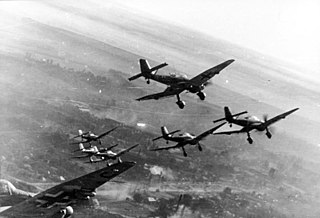
World War II or the Second World War, often abbreviated as WWII or WW2, was a global conflict that lasted from 1939 to 1945. The vast majority of the world's countries, including all of the great powers, fought as part of two opposing military alliances: the Allies and the Axis. Many participants threw their economic, industrial, and scientific capabilities behind this total war, blurring the distinction between civilian and military resources. Aircraft played a major role, enabling the strategic bombing of population centres and the delivery of the only two nuclear weapons ever used in war. World War II was by far the deadliest conflict in history, resulting in an estimated 70 to 85 million fatalities, mostly among civilians. Tens of millions died due to genocides, starvation, massacres, and disease. In the wake of the Axis defeat, Germany and Japan were occupied, and war crimes tribunals were conducted against German and Japanese leaders.
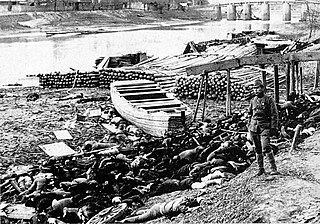
The Nanjing Massacre or the Rape of Nanjing was the mass murder of Chinese civilians in Nanjing, the capital of the Republic of China, immediately after the Battle of Nanking in the Second Sino-Japanese War, by the Imperial Japanese Army. Beginning on December 13, 1937, the massacre lasted six weeks. The perpetrators also committed other war crimes such as mass rape, looting, and arson. The massacre was one of the worst atrocities committed, even by the standards of World War II.
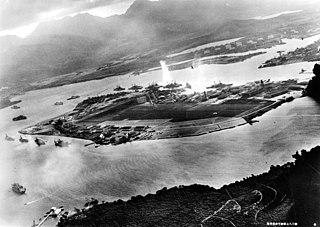
The attack on Pearl Harbor was a surprise military strike by the Imperial Japanese Navy Air Service upon the United States against the U.S. naval base at Pearl Harbor in Honolulu, Hawaii, just before 8:00 a.m. on Sunday, December 7, 1941. The United States was a neutral country at the time; the attack led to its formal entry into World War II on the side of the Allies the next day. The Japanese military leadership referred to the attack as the Hawaii Operation and Operation AI, and as Operation Z during its planning.
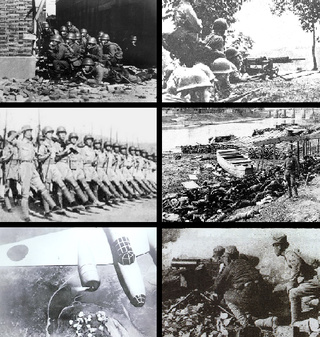
The Second Sino-Japanese War (1937–1945) or War of Resistance against Japanese Aggression was a military conflict primarily between the Republic of China and the Empire of Japan. The war made up the Chinese theater of the wider Pacific Theater of the Second World War. The beginning of the war is conventionally dated to the Marco Polo Bridge Incident on 7 July 1937, when a dispute between Japanese and Chinese troops in Beijing escalated into a full-scale invasion. Some Chinese historians consider the start of the war as the Japanese invasion of Manchuria on 18 September 1931. China was aided by the Soviet Union, the United Kingdom, the United States, and Nazi Germany before its alliance with Japan. Around 20 million people, mostly civilians, were killed.

The Japan Broadcasting Corporation, also known as NHK, is a Japanese public broadcaster. NHK, which has always been known by this romanized initialism in Japanese, is a statutory corporation funded by viewers' payments of a television license fee.

The Empire of Japan, also known as the Japanese Empire, Imperial Japan, or simply Japan, was a historical nation-state that existed from the Meiji Restoration in 1868 until the enactment of the post–World War II 1947 constitution and subsequent formation of modern Japan. From 29 August 1910 when having Korea until 2 September 1945, the empire administered the naichi and gaichi. South Seas Mandate was single Japanese dependent territory in the name of the League of Nations. In 1945, in compliance with the Potsdam Declaration of the victorious Allies, Japanese de facto territory only remained the Japanese archipelago as it is today.

Unit 731, short for Manshu Detachment 731 and also known as the Kamo Detachment and the Ishii Unit, was a covert biological and chemical warfare research and development unit of the Imperial Japanese Army that engaged in lethal human experimentation and biological weapons manufacturing during the Second Sino-Japanese War (1937–1945) and World War II. The unit is estimated to have killed between 200,000 and 300,000 people. It was based in the Pingfang district of Harbin, the largest city in the Japanese puppet state of Manchukuo and had active branch offices throughout China and Southeast Asia.
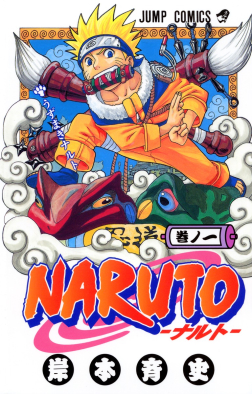
Naruto is a Japanese manga series written and illustrated by Masashi Kishimoto. It tells the story of Naruto Uzumaki, a young ninja who seeks recognition from his peers and dreams of becoming the Hokage, the leader of his village. The story is told in two parts—the first set in Naruto's pre-teen years, and the second in his teens. The series is based on two one-shot manga by Kishimoto: Karakuri (1995), which earned Kishimoto an honorable mention in Shueisha's monthly Hop Step Award the following year, and Naruto (1997).
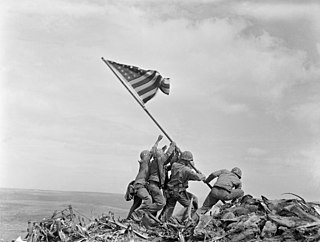
The Pacific War, sometimes called the Asia–Pacific War, was the theater of World War II that was fought in eastern Asia, the Pacific Ocean, the Indian Ocean, and Oceania. It was geographically the largest theater of the war, including the vast Pacific Ocean theater, the South West Pacific theater, the Second Sino-Japanese War, and the Soviet–Japanese War.

One Piece is a Japanese manga series written and illustrated by Eiichiro Oda. It has been serialized in Shueisha's shōnen manga magazine Weekly Shōnen Jump since July 1997, with its individual chapters compiled into 105 tankōbon volumes as of March 2023. The story follows the adventures of Monkey D. Luffy and his crew, the Straw Hat Pirates, where he explores the Grand Line in search of the mythical treasure known as the "One Piece" in order to become the next King of the Pirates.

The Japan national football team, nicknamed the Samurai Blue, represents Japan in men's international football. It is controlled by the Japan Football Association (JFA), the governing body for football in Japan.

On 6 and 9 August 1945, the United States detonated two atomic bombs over the Japanese cities of Hiroshima and Nagasaki, respectively. The aerial bombings together killed between 129,000 and 226,000 people, most of whom were civilians, and remain the only use of nuclear weapons in an armed conflict. Japan surrendered to the Allies on 15 August, six days after the bombing of Nagasaki and the Soviet Union's declaration of war against Japan and invasion of Japanese-occupied Manchuria. The Japanese government signed the instrument of surrender on 2 September, effectively ending the war.

On 11 March 2011, at 14:46 JST, a Mw 9.0–9.1 undersea megathrust earthquake occurred in the Pacific Ocean, 72 km (45 mi) east of the Oshika Peninsula of the Tōhoku region. It lasted approximately six minutes, causing a tsunami. It is sometimes known in Japan as the "Great East Japan Earthquake", among other names. The disaster is often referred to as simply 3.11.

On 11 March 2011, a nuclear accident occurred at the Fukushima Daiichi Nuclear Power Plant in Ōkuma, Fukushima, Japan. The proximate cause of the disaster was the Tōhoku earthquake and tsunami, which remains the most powerful earthquake ever recorded in Japan. The earthquake triggered a powerful tsunami, with 13- to 14-meter-high waves damaging the nuclear power plant's emergency diesel generators, leading to a loss of electric power. The result was the most severe nuclear accident since the Chernobyl disaster in 1986, classified as level seven on the International Nuclear Event Scale (INES) after initially being classified as level five, and thus joining Chernobyl as the only other accident to receive such classification. While the 1957 explosion at the Mayak facility was the second worst by radioactivity released, the INES ranks incidents by impact on population, so Chernobyl and Fukushima rank higher than the 10,000 evacuated from the Mayak site in the rural southern Urals.